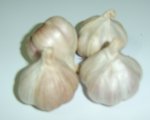

| Materials | Methods of preparation | How to use | Target pests |
| Garlic bulb extract
(Vijayalakshmi; et.al, 1999: pp. 1-23) 85 grams of chopped garlic 50 ml of mineral oil (kerosene or vegetable oil) 10 ml of soap 950 ml of water Strainer Bottle container |
Add garlic to vegetable oil. Allow mixture to stand for 24 hours. Add water and stir in the soap. Store in bottle container. |
Dilute 1 part of the emulsion with 19 parts of water (for example, 50 ml of emulsion to 950 ml of water). Shake well before spraying. Spray thoroughly on the infested plant, preferably early in the morning. |
American bollworm Armyworm Cotton stainer Onion thrips Potato tuber moth Root knot nematode Sugarcane shoot borer Bacterial diseases Anthracnose Downy mildew Rice blast |
| Garlic bulb
extract
(Brooklyn Botanic Garden, 2000: p. 98) 2 garlic bulbs Few drops of soap 4 cups of water Grinder Strainer Bottle container |
Grind garlic. Allow mixture to stand for 24 hours. Add water and stir in the soap. Store in bottle container. Strain before using. |
Dilute 1 part of the emulsion with 9 parts of water. Shake well before spraying. Spray thoroughly on the infested plant, preferably early in the morning. |
Black spots Blights Fruit rots Mildew Rusts |
| Garlic oil spray
(Ellis; Bradley, 1996: p. 473) 100 grams of garlic 2 tbsp of mineral oil 10.5 liters of water 10 ml of soap Covered container |
Chop garlic finely. Soak garlic in mineral oil for a day. Add œ liter of water and soap. Blend well by stirring thoroughly. Strain. |
Dilute the filtrate with 10 liters of water. Fill the sprayer. Shake sprayer from time to time to avoid oil from floating. Spray on the infested plant thoroughly. |
Imported cabbage worm Leafhoppers Squash bugs Whitefly |
| Garlic oil emulsion
(Vijayalakshmi; et.al, 1999: pp. 1-23) 50 ml of garlic oil 950 ml of water 1 ml of soap |
Add soap to oil. Blend well by stirring thoroughly. Add water. Stir. |
To prevent oil from floating, immediately spray extract on infested plants and shake sprayer from time to time. Spray early in the morning or late afternoon. |
American bollworm Potato tuber moth Rice blast Rice brown leaf spot Root knot nematode |